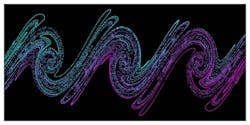New simulation tools improve understanding of laser/plasma coupling interactions
A new 3D particle-in-cell (PIC) simulation tool developed by researchers from Lawrence Berkeley National Laboratory (LBNL or Berkeley Lab; Berkeley, CA) and CEA Saclay (Saclay, France) is enabling simulations of laser/plasma coupling mechanisms that were previously out of reach of standard PIC codes used in plasma research. More detailed understanding of these mechanisms is critical to the development of ultracompact particle accelerators and light sources that could solve long-standing challenges in medicine, industry, and fundamental science more efficiently and cost effectively.
In laser-plasma experiments such as those at the Berkeley Lab Laser Accelerator (BELLA) Center and at CEA Saclay—an international research facility in France that is part of the French Atomic Energy Commission—very large electric fields within plasmas that accelerate particle beams to high energies over much shorter distances when compared to existing accelerator technologies. The long-term goal of these laser-plasma accelerators (LPAs) is to one day build colliders for high-energy research, but many spin offs are being developed already. For instance, LPAs can quickly deposit large amounts of energy into solid materials, creating dense plasmas and subjecting this matter to extreme temperatures and pressure. They also hold the potential for driving free-electron lasers that generate light pulses lasting just attoseconds. Such extremely short pulses could enable researchers to observe the interactions of molecules, atoms, and even subatomic particles on extremely short timescales.
Supercomputer simulations have become increasingly critical to this research, and Berkeley Lab's National Energy Research Scientific Computing Center (NERSC) has become an important resource in this effort. By giving researchers access to physical observables such as particle orbits and radiated fields that are hard to get in experiments at extremely small time and length scales, PIC simulations have played a major role in understanding, modeling, and guiding high-intensity physics experiments. But a lack of PIC codes that have enough computational accuracy to model laser-matter interaction at ultrahigh intensities has hindered the development of novel particle and light sources produced by this interaction.
This challenge led the Berkeley Lab/CEA Saclay team to develop their new simulation tool, dubbed Warp+PXR, an effort started during the first round of the NERSC Exascale Science Applications Program (NESAP). The code combines the widely used 3D PIC code Warp with the high-performance library PICSAR co-developed by Berkeley Lab and CEA Saclay. It also leverages a new type of massively parallel pseudo-spectral solver co-developed by Berkeley Lab and CEA Saclay that dramatically improves the accuracy of the simulations compared to the solvers typically used in plasma research.
In fact, without this new, highly scalable solver, "the simulations we are now doing would not be possible," said Jean-Luc Vay, a senior physicist at Berkeley Lab who heads the Accelerator Modeling Program in the Lab's Applied Physics and Accelerator Technologies Division. "As our team showed in a previous study, this new FFT spectral solver enables much higher precision than can be done with finite difference time domain (FDTD) solvers, so we were able to reach some parameter spaces that would not have been accessible with standard FDTD solvers." This new solver is also at the heart of the next-generation PIC algorithm with adaptive mesh refinement that Vay and colleagues are developing in the new Warp-X code as part of the U.S. Department of Energy's Exascale Computing Project.
"We cannot consistently repeat or reproduce what happened in the experiment with 2D simulations—we need 3D for this," said co-author Henri Vincenti, a scientist in the high-intensity physics group at CEA Saclay. Vincenti led the theoretical/simulation work for the new study and was a Marie Curie postdoctoral fellow at Berkeley Lab in Vay's group, where he first started working on the new code and solver. "The 3D simulations were also really important to be able to benchmark the accuracy brought by the new code against experiments."
For the experiment outlined in the Physical Review X paper, the CEA Saclay researchers used a high-power (100TW) femtosecond laser beam at CEA's UHI100 facility focused on a silica target to create a dense plasma. In addition, two diagnostics—a Lanex scintillating screen and an extreme-ultraviolet (EUV) spectrometer—were applied to study the laser-plasma interaction during the experiment. The diagnostic tools presented additional challenges when it came to studying time and length scales while the experiment was running, again making the simulations critical to the researchers’ findings.
"The first-principles simulations we used for this research gave us access to the complex dynamics of the laser field interaction, with the solid target at the level of detail of individual particle orbits, allowing us to better understand what was happening in the experiment," Vincenti added.
NERSC is a U.S. DOE Office of Science User Facility. Additional support for this research was provided by the Innovative and Novel Computational Impact on Theory and Experiment (INCITE) program.
SOURCE: Lawrence Berkeley National Laboratory; https://cs.lbl.gov/news-media/news/2019/a-breakthrough-in-the-study-of-laserplasma-interactions/
About the Author

Gail Overton
Senior Editor (2004-2020)
Gail has more than 30 years of engineering, marketing, product management, and editorial experience in the photonics and optical communications industry. Before joining the staff at Laser Focus World in 2004, she held many product management and product marketing roles in the fiber-optics industry, most notably at Hughes (El Segundo, CA), GTE Labs (Waltham, MA), Corning (Corning, NY), Photon Kinetics (Beaverton, OR), and Newport Corporation (Irvine, CA). During her marketing career, Gail published articles in WDM Solutions and Sensors magazine and traveled internationally to conduct product and sales training. Gail received her BS degree in physics, with an emphasis in optics, from San Diego State University in San Diego, CA in May 1986.
